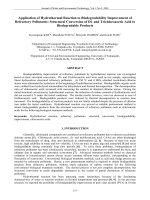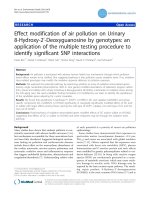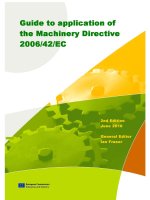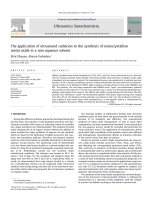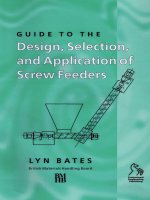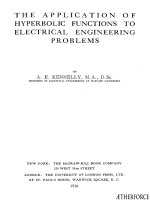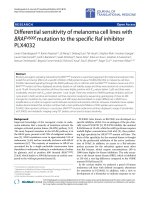- Trang chủ >>
- Khoa Học Tự Nhiên >>
- Vật lý
APPLICATION OF q DEFORMED FERMI DIRAC STATISTICS TO THE SPECIFIC HEAT CAPACITY OF FREE ELECTRONS OF METALS
Bạn đang xem bản rút gọn của tài liệu. Xem và tải ngay bản đầy đủ của tài liệu tại đây (216.02 KB, 8 trang )
Proc. Natl. Conf. Theor. Phys. 36 (2011), pp. 140-147
APPLICATION OF Q-DEFORMED FERMI-DIRAC STATISTICS
TO THE SPECIFIC HEAT CAPACITY OF
FREE ELECTRONS OF METALS
VU VAN HUNG, DUONG DAI PHUONG
Hanoi National University of Education, 136 Xuan Thuy Street, Hanoi
LUU THI KIM THANH
Hanoi Pedagogical University No2, Xuan Hoa, Phuc Yen, Vinh Phuc
Abstract. In this article, the contribution of free electrons to the specific heat capacity of metals in low temperature has been investigated by using the q-deformed fermi-dirac statistics. We
have obtained the analytical expressions of the specific heat capacity of metals and the value of
q-deformed parameter. Present theoretical calculations of specific heat capacity for some kinds
of alkali and transition metals have been performed and compared with the experimental results
showing the agreement.
I. INTRODUCTION
Metal is a solid which contains many electrons that can move freely throughout
the crystal. So it has a good electrical conductivity which is about 106 to 108 Ω−1 m−1 .
Each atom in material has only one electron, there would be about 1022 valence electrons
in a cm3 . Depending on the distribution function used to consider free-electron gas we
will have different theories: If free electrons are considered as simplest classical gas which
have the same energy value, we use Drudes theory to analyze issues about metal. If the
Maxwell-Boltzmann distribution function is used to analyze classical gas, it is applied
according to Lorentzs theory. If the Fermi-Dirac distribution function is used to do this, it
is applied according to Sommerfelds theory. The specific heat capacity of the free electrons
in metals have been studied from these theories [1, 2, 3]. In present article, we propose
other plan applying the statistical distribution of Fermi-Dirac -q deformation to study the
heat capacity of free-electron gas in metals at low temperatures [4, 6]. We have obtained
the analytic expressions of the specific heat capacity of metals and the value of q-deformed
parameter. Present theoretical calculations of specific heat capacity for some kinds of alkali
and transition metals have been performed and compared with the experimental results.
II. THEORY
At very low temperature, free electron gas in metals via the fermi-dirac statistics
and the heat capacity at constant volume ratio is linear with absolute temperature [2, 3].
CVe = γT
(1)
APPLICATION OF Q-DEFORMED FERMI-DIRAC STATISTICS TO...
141
In the q-deformed Fermions oscillator operators satisfying the relation contrast commutative [4, 5, 6].
ˆbˆb+ + qˆb+ˆb = q −Nˆ
(2)
where N is oscillator number operator and q is a deformation parameter.
with the q-deformed Fermions:
{n}q =
q −n − (−1)n q n
q + q −1
(3)
In statistical physics the thermal average expression of the operator Fˆ is given as:
(
{
} )
ˆ
ˆ .Fˆ
⟨ ⟩ T r exp −β(H−µ
N)
(
{
})
Fˆ =
ˆ
ˆ
T r exp −β(H−µ
N)
(4)
where µ is the chemical, H is the Hamiltonian operator of the system, β = 1/kT , k
is Boltzmann constant, T is the absolute temperature. From equations (4) the average
number of particles with the same level of energy can be calculated as
(
{
} )
ˆ
ˆ .N
ˆ
⟨ ⟩ T r exp −β(H−µ
N)
ˆ =
(
{
})
(5)
N
ˆ
ˆ
T r exp −β(H−µ
N)
The(calculations give following results:
{
} { } )
{ }
∞
∑
ˆ
ˆ
ˆ
ˆ
ˆ |n⟩
=
⟨n|e−β(ε−µ)N N
T r exp −β(H − µN ) . N
=
=
∞
∑
n=0
∞
∑
q
⟨n|e−β(ε−µ)n {n}q |n⟩ =
e−β(ε−µ)n . q
[
n=0
=
1
q+q −1
=
1
q+q −1
∞ (
∑
[ n=0
∞
∑
n=0
q
n=0
e−β(ε−µ)n {n}q
−n −(−1)n q n
q+q −1
)n
q −1 .e−β(ε−µ)
−
∞ (
∑
n=0
1
1−q −1 .e−β(ε−µ)
−
1
)n
−q.e−β(ε−µ)
]
]
1+q.e−β(ε−µ)
=
e−β(ε−µ)
1 + (q − q −1 )e−β(ε−µ) − e−2β(ε−µ)
(6)
(
{
})
∞
∑
ˆ
ˆ − µN
ˆ)
T r exp −β(H
=
⟨n|e−β(ε−µ)N |n⟩
=
∞
∑
n=0
⟨n|e−β(ε−µ)n |n⟩
=
∞
∑
n=0
e−β(ε−µ)n
n=0
=
1
1−
e−β(ε−µ)
(7)
142
VU VAN HUNG, DUONG DAI PHUONG, LUU THI KIM THANH
Substituting equation (6) and equation (7) into equation (5), we obtain the Fermi-Dirac
distribution function q-deform Fermi Dirac as:
⟨ ⟩
eβ(ε−µ) − 1
ˆ =
n
¯ (ε) = N
(8)
e2β(ε−µ) + (q − q −1 )eβ(ε−µ) − 1
Total number of free electrons and the total energy of free electron gas at temperature T
are [1, 2].
∫∞
N = ρ(ε).¯
n(ε)dε
(9)
0
∫∞
E=
ε.ρ(ε).¯
n(ε)dε
(10)
0
where ρ(ε) is the density of states defined as:
g(ε).V
(2m)3/2 .ε1/2
(11)
4π 2 3
Here n
¯ (ε) is the average number of particles with energies ε and g(ε) is the multiple
degeneracy of each energy level ε.
3/2
From equations (8), (9), (10) and using α = V.(2m)
we can be rewritten as
2π 2 3
ρ(ε) =
∫∞
N =α
ε
1/2
e
.
e
0
2 ε−µ
kT
∫∞
0
e
2 ε−µ
kT
−1
+ (q − q −1 )e
e
ε3/2 .
E=α
ε−µ
kT
ε−µ
kT
ε−µ
kT
−1
ε−µ
kT
−1
−1
+ (q − q −1 )e
dε
(12)
dε
(13)
Perform calculations and when T → 0K we obtained [2].
2
3/2
N = α.µ0
3
2
3
5/2
E0 = α.µ0 = µ0 N
5
5
Where µ0 is the chemical at T = 0K given as:
( 2 ) 23 (
)2
2
3π N
3N 3
µ0 =
=
2m
V
2α
(14)
(15)
(16)
At very low temperature T ̸= 0K, from equations (12), (13), (14), (15), (16) perform
transformations and when 0 < q < 1 we determine the total energy of free electron gas at
temperature T :
]
[
F (q)(kT )2
(17)
E = E0 1 + 5.
µ20
APPLICATION OF Q-DEFORMED FERMI-DIRAC STATISTICS TO...
From equation (15) and equation (17)we obtained.
]
[
3
F (q)(kT )2
E = N µ0 1 + 5.
5
µ20
143
(18)
where
[
]
∞
∞
∞
∞
∑
∑
∑
∑
−1
(−q)k
(q)k
(−q)k
(q)k
+ (1 + q)
−q
+
F (q) = 2
q(q − 1)
q +1
k2
k2
k3
k3
k=1
k=1
k=1
(19)
k=1
Heat capacity at constant volume of free electrons gas in metals for the case of the
deformation-q.
(
)
∂E
N F (q)k 2 T
el
CV =
= 6.
= γ bd T
(20)
∂T V
µ0
So at very low temperatures, the heat capacity of free-electron gas in metals when deformed
q-ratio is linear with temperature. From equation (1) and equation (20) we inferred
expressions as:
µ0 γ
F (q) =
(21)
6N K 2
γ bd = 6.
N.k 2 .F (q)
µ0
(22)
The experimental values of the Fermi energy and electron thermal constants of metals as
Table 1 [7].
III. NUMERICAL RESULTS AND DISCUSSIONS
We replace the experimental values of the Fermi energy and electron thermal constants of metals (Table 1) in expression (21) and (22), find out the expression for F (q)
by using the software Maple estimates, and obtain the value of strain-q parameter for
metals presented as table 2. Present calculation results also suggest that for alkali and
earth metals with the same number of outer electrons layer, the value of the parameter q
and the function F (q) are larger than those of the transition metal, and contribute to the
electron heat capacity is larger, while for the transition metals the outer electron layer of
the layered d, f , the value of deformation parameter q and the function F (q) that it is
smaller than the alkali metals the electron contribution to heat smaller. Table 2 shown
that the value of the parameter q are the same equaling 0.642 for the alkali metals, and
the value of q are the same equaling 0.564 for the transition metals. We used these values
of the parameter q for each metal and draw the graph in Fig. 1.1 to Fig. 1.5, shows the
results fit well with the experiment.
144
VU VAN HUNG, DUONG DAI PHUONG, LUU THI KIM THANH
Table 1. The experimental values of the Fermi energy and electron thermal constants of the metals.
M etal
µ0 (eV )
γ(mJ.mol−1 .K −2 )
Cs
1.58
3.20
K
2.12
2.08
Na
3.23
1.38
Ba
3.65
2.7
Sr
3.95
3.6
Ca
4.68
2.9
Li
4.72
1.63
Ag
5.48
0.646
M etal
µ0 (eV )
γ(mJ.mol−1 .K −2 )
Au
5.51
0.72
Cu
7.0
0.59
Cd
7.46
0.68
Zn
9.39
0.64
Ga
10.35
0.595
Al
11.03
1.35
Be
11.11
0.17
Mg
17.1
1.3
Table 2. Experimental and theoretical values of parameters γ and deformation
parameters of the electrons in metals.
M etal
Na
K
Rb
Cs
Be
Cu
Ag
Au
Cd
γ T N (mJ.mol−1 .K −2 )
1.38
2.08
2.41
3.20
0.17
0.595
0.646
0.729
0.688
γ bd (mJ.mol−1 .K −2 )
1.379
2.079
2.409
3.199
0.215
0.594
0.645
0.728
0.562
q
0.642
0.627
0.642
0.835
0.279
0.563
0.442
0.531
0.570
F (q)
1.036662
1.025545
1.036954
1.175845
0.559054
0.968659
0.823320
0.934189
0.975432
IV. CONCLUSIONS
The heat capacity of free-electron gas in metals at low temperatures has been investigated by applying the statistical distribution of Fermi-Dirac -q deformation. We have
obtained the analytic expressions of the specific heat capacity of metals and the value
of q-deformed parameter. Present theoretical calculations of specific heat capacity for
some kinds of alkali and transition metals have been performed and compared with the
experimental results.
REFERENCES
[1] A. A. Abrikosov, L. P. Gorkov, I. E. Dzualoshinskii, Methods of Quantum Theory field in statistical
Physic, 1962 Fizmatgiz, Moscow.
[2] Vu Van Hung, Statistical Physics, DH (2006).
[3] C. Kittel, Introduction to Solid State Physics, 6th Ed., 1986 J. Wiley-Sons Lac.
[4] Luu Thi Kim Thanh, Comm. Phys. 8 (1998).
[5] D. V. Duc, Preprint ENSLAPP A 494 (1994) 94 (Annecy France).
[6] D. V. Duc, L. T. K. Thanh, Comm. Phys. TNo 1.2 (1997).
[7] Dang Mong Lan, Tran Huu Phat, (A translation from the Charles Kittel’s book), Introduction to solid
state physics, NXB KHKT (1984), pp. 40-60.
[8] L. M. Kuang, Mod. Phys. Lett. 7 (1992) 2593-2600.
APPLICATION OF Q-DEFORMED FERMI-DIRAC STATISTICS TO...
Fig. 1. Temperature dependence of the specific heat capacity of electrons for sodium.
Fig. 2. Temperature dependence of the specific heat capacity of electrons for potassium.
[9] R. Chakrbarti, R. Jagarnathan, J. Phys. A: Math. Gen. 25 (1992) 6393.
[10] S. Chartuvedi, V. Srinivasan, Phys. Rev. A 44 (1991) 8020.
[11] Y. Yang, Z. Yu, Mod. Phys. Lett. A 9 (1994) 3367-3372 .
145
146
VU VAN HUNG, DUONG DAI PHUONG, LUU THI KIM THANH
Fig. 3. Temperature dependence of the specific heat capacity of electrons for sexi.
Fig. 4. Temperature dependence of the specific heat capacity of electrons for silver.
[12] H. H. Bang, Proceeding of the NCST of Viet Nam 7 (1995).
[13] L. C. Biedenhar, J. Phys. A: Math. Gen. 22 (1989) 1873.
[14] N. Aizawa, H. Sato, Phys Rics Letters Bvol. 256 (1991) 185.
APPLICATION OF Q-DEFORMED FERMI-DIRAC STATISTICS TO...
147
Fig. 5. Temperature dependence of the specific heat capacity of electrons for gold.
[15] M. Chaichian, P.P. Kulish, Preprint CERN TH 90(1990) 5969.
[16] R. Chakrbarti, R. Jagarnathan, ıPreprint CERN TH 256 (1992) 6393-6398.
[17] K. H. Cho, C. Rim, D. S. Soh, S. U. Park, J. Phys. A: Math. Gen. 27 (1994) 2811-2822.
Received 30-09-2011.
